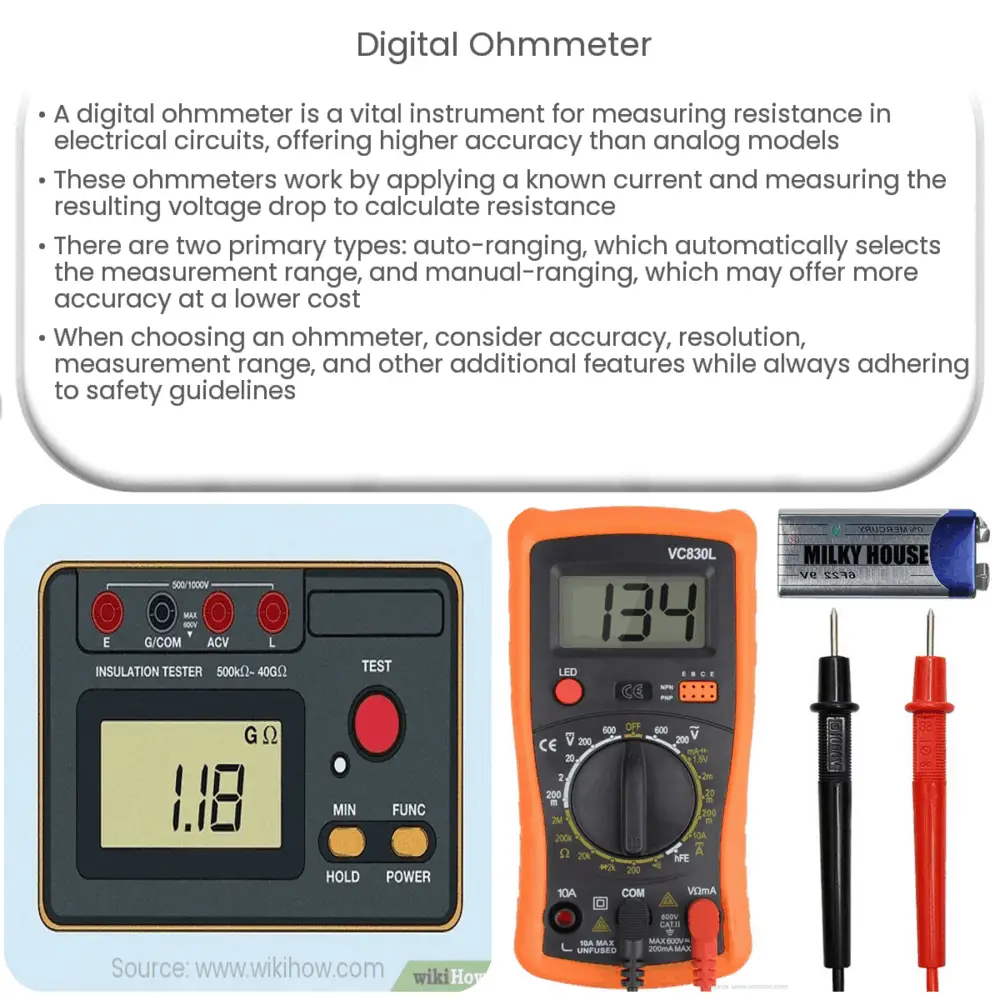A digital ohmmeter is an accurate, user-friendly device for measuring resistance in electrical circuits, essential for electricians and electronics enthusiasts.

Digital Ohmmeter: An Essential Tool for Electrical Measurements
A digital ohmmeter is a versatile and indispensable instrument used by electricians, electronics hobbyists, and professionals alike for measuring resistance in electrical circuits. This modern device has significantly improved the accuracy and efficiency of resistance measurements compared to its analog counterpart, making it an essential tool in today’s fast-paced electronics industry.
How Digital Ohmmeters Work
At its core, a digital ohmmeter functions by passing a known current through the component or circuit under test and measuring the resulting voltage drop. The resistance value can then be calculated using Ohm’s Law (R = V/I), where R is the resistance, V is the voltage drop, and I is the current. The digital ohmmeter then displays the resistance value in ohms (Ω) on its digital screen.
Types of Digital Ohmmeters
There are two main types of digital ohmmeters: auto-ranging and manual-ranging. Each type offers its own unique set of advantages and disadvantages, depending on the user’s specific requirements.
Auto-ranging Ohmmeters
Auto-ranging ohmmeters are designed to automatically select the appropriate range for measuring the resistance value. This makes them convenient to use, as the user does not need to manually set the range before taking a measurement. Auto-ranging ohmmeters are particularly helpful for beginners or those who need to take multiple measurements quickly, as they can save time and reduce the risk of measurement errors.
Manual-ranging Ohmmeters
Manual-ranging ohmmeters, on the other hand, require the user to manually set the appropriate range for the resistance value being measured. Although this may seem less convenient than auto-ranging, manual-ranging ohmmeters often provide more accurate measurements, especially when dealing with components with low resistance values. Additionally, they tend to be less expensive than auto-ranging models, making them a popular choice among electronics enthusiasts on a budget.
Features to Consider When Choosing a Digital Ohmmeter
When selecting a digital ohmmeter, it’s essential to consider the features that will best suit your needs. Here are some important factors to keep in mind:
- Accuracy: Look for a digital ohmmeter with a high level of accuracy, typically within ±0.5% to ±1% of the measured value. This will ensure that your measurements are precise and reliable.
- Resolution: The resolution of an ohmmeter refers to the smallest increment of resistance it can measure. Higher resolution ohmmeters can detect smaller changes in resistance, making them more suitable for applications requiring precise measurements.
- Measurement Range: Ensure the ohmmeter you choose can measure the resistance values you expect to encounter in your projects. Some digital ohmmeters offer a wider range of resistance measurements, making them more versatile.
Additional Features
Beyond the basic functionality, many digital ohmmeters come with additional features that can enhance their usability and utility. Some of these features include:
- Data Hold: This feature allows the user to freeze the current measurement on the display, making it easier to read and record the value without having to rush.
- Backlit Display: A backlit display improves visibility in low-light conditions, allowing for accurate readings in a variety of environments.
- Continuity Test: Some digital ohmmeters offer a continuity testing function that can quickly determine if an electrical connection is present between two points in a circuit. This is particularly useful for troubleshooting and identifying faulty components.
- Capacitance Measurement: Some advanced models include the ability to measure capacitance, which can be helpful for testing capacitors and diagnosing issues in electronic circuits.
Safety Considerations
When using a digital ohmmeter, it’s crucial to follow safety guidelines to protect yourself and your equipment. Here are some important safety tips:
- Always turn off the power to the circuit or component you are testing before connecting the ohmmeter. This will prevent damage to the meter and ensure accurate measurements.
- Use caution when working with high voltages or currents. Make sure to use insulated tools and wear appropriate personal protective equipment (PPE) when necessary.
- Always consult the user manual for your specific digital ohmmeter model to familiarize yourself with its functions and safety precautions.
Conclusion
A digital ohmmeter is an essential tool for anyone working with electronics, whether professionally or as a hobby. By understanding how these devices work, the different types available, and the features to consider when selecting a model, you can make an informed decision and choose the best digital ohmmeter for your needs. Remember to prioritize accuracy, resolution, and measurement range, and consider any additional features that may be useful in your specific applications. Finally, always follow safety guidelines to protect yourself and your equipment while taking accurate and reliable resistance measurements.

